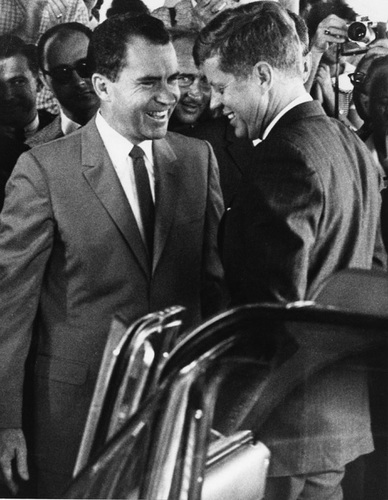
–>
June 6, 2023
Credible allegations of voter fraud in the 2020 presidential election have resulted in profound misgivings among Americans. Many conservatives have become disillusioned with the Republican party, especially at the national level where the gap between rhetoric and results has grown enormously. However, the nation has experienced similar circumstances in the past. What lessons can we draw from the history of previous elections?
‘); googletag.cmd.push(function () { googletag.display(‘div-gpt-ad-1609268089992-0’); }); document.write(”); googletag.cmd.push(function() { googletag.pubads().addEventListener(‘slotRenderEnded’, function(event) { if (event.slot.getSlotElementId() == “div-hre-Americanthinker—New-3028”) { googletag.display(“div-hre-Americanthinker—New-3028”); } }); }); }
The 1960 election was a pivotal point in American politics. Given that only one in five current Americans were alive then, as well as the continuing decline in proficiency in history and civics, let us consider how this contest compares to our most recent presidential election.
In 1960 the Republican candidate was the sitting vice president, Richard Nixon, serving in the Eisenhower administration. The Democratic candidate was John F. Kennedy, the senator from Massachusetts. In terms of the popular vote, this is considered the second-closest presidential election in the nation’s history. Kennedy won 49.72% of the votes cast versus the 49.55% won by Nixon. The presidency is determined, of course, not by the popular vote but rather the votes cast in the electoral college. Per the Constitution of the United States, each state is allotted electors equal to the number of its members in the House of Representatives plus its two senators. Thus, the state of Georgia, for example, with its fourteen representatives plus two senators, currently has a total of sixteen electors. The larger a state’s population the more representatives it has, such that California has 55 electors while several states have only three. These numbers can vary over time as a state gains or loses representatives due to changes in population.
Based on the total number of electors in 1960, a candidate had to win at least 269 to have a majority. As close as the popular vote was, the difference in electoral votes was significant, with Kennedy gaining 303 versus 219 for Nixon. The reason for the disparity is that voters do not directly choose the presidential candidate, but rather vote for a slate of electors, who in turn vote for the candidate. Each party, Republican, Democrat, or other, fields its own slate. Usually then, in most states the popular vote determines which slate will serve and therefore, which candidate wins all the state’s electoral votes.
‘); googletag.cmd.push(function () { googletag.display(‘div-gpt-ad-1609270365559-0’); }); document.write(”); googletag.cmd.push(function() { googletag.pubads().addEventListener(‘slotRenderEnded’, function(event) { if (event.slot.getSlotElementId() == “div-hre-Americanthinker—New-3035”) { googletag.display(“div-hre-Americanthinker—New-3035”); } }); }); }
However, the election of 1960 was anything but usual. Several state Democratic parties worked to put unpledged electors on the ballot. Thus, it happened, for example, that Alabama voters chose five electors who were pledged to and voted for Kennedy, but also chose six unpledged electors, who ultimately voted for the segregationist Democratic Senator Harry F. Byrd of Virginia.
 Consider the 1960 results in the states of Texas and Illinois. In Texas, Kennedy received 1,167,567 (50.52%) against 1,121,310 (48.52%) for Nixon, for 24 electoral votes. In Illinois, Kennedy received 2,377,846 votes (49.98% of votes cast) versus Nixon’s 2,368,988 (49.80%) and therefore gained the state’s 27 votes.
Consider the 1960 results in the states of Texas and Illinois. In Texas, Kennedy received 1,167,567 (50.52%) against 1,121,310 (48.52%) for Nixon, for 24 electoral votes. In Illinois, Kennedy received 2,377,846 votes (49.98% of votes cast) versus Nixon’s 2,368,988 (49.80%) and therefore gained the state’s 27 votes.
A mere 112,287 votes separated the two candidates out of a total of 68,832,482 cast nationwide. In such a closely divided election the potential for any irregularity, either by simple human error or by intentional fraud, to affect the outcome is significant. Had Nixon prevailed in both Texas and Illinois, he would have been the nation’s 35th president rather than Kennedy.
Naturally, this gave rise to serious allegations of election fraud and Republicans soon uncovered a number of irregular results. The Washington Post noted one instance in Texas: “In Fannin County, which had 4,895 registered voters, 6,138 votes were cast, three-quarters of them for Kennedy.” More votes cast than registered voters — where have we heard that recently?
Although President Eisenhower and many others urged Nixon to contest the election, he ultimately decided not to, telling one journalist “our country cannot afford the agony of a constitutional crisis.” My point is not to judge whether the 1960 or the 2000 (Bush vs. Gore) or the 2020 presidential elections were honest. Millions of words could be written — and have been — debating their outcomes. Rather, I want to note that every election has the potential for irregularities that call its result into question, causing serious distrust in voters’ minds and damaging their confidence in the integrity of the government.
History would teach us that honest elections are not an inevitable outcome of our political system. They never have been. If we are to have fair elections, we must work to ensure our votes are accurately recorded. So, what are some actionable steps we can take to make the 2024 election an honest one?
‘); googletag.cmd.push(function () { googletag.display(‘div-gpt-ad-1609268078422-0’); }); document.write(”); googletag.cmd.push(function() { googletag.pubads().addEventListener(‘slotRenderEnded’, function(event) { if (event.slot.getSlotElementId() == “div-hre-Americanthinker—New-3027”) { googletag.display(“div-hre-Americanthinker—New-3027”); } }); }); } if (publir_show_ads) { document.write(“
First, we can pray — always the best first step when dealing with any problem.
Second, we can participate in our local party activities at the precinct and county levels. Consider working to register new voters who agree with your principles.
Third, we can keep an eye on the process as it occurs. Consider volunteering to be a poll worker or a poll watcher.
Fourth, we can, with our time and money, support candidates who align with our values, or even consider becoming a candidate ourselves.
What we must not do is allow a sense of fatalism to cause us to withdraw from political activity. This is no time to retire to the sidelines. Instead, look for opportunities to impact the 2024 elections. For this article I have focused on presidential elections, but local and state elections are just as important. Don’t believe it? Consider the impact that district attorneys have had in just the past two years on the maladministration of the justice system. Alvin Bragg of New York County; Kim Gardner of St. Louis, Missouri; Kim Foxx of Cook County, Illinois; and Buta Biberaj of Loudoun County, Virginia are a few examples.
If all that sounds like too much effort, the alternative is to just sit back and complain about the election results. It’s your call, either to do nothing or to step up and take the actions that are available to you.
In his inaugural address as Lord Rector of the University of St Andrews, delivered on February 1, 1867, John Stuart Mill said, “Bad men need nothing more to compass their ends, than that good men should look on and do nothing.” I believe there are enough good men and women in America to ensure the elections of 2024 accurately represent the choices of the people.
Harold Lowery is the author of From Lexington to Yorktown. Warning: This novel references actual American history.
Image: Picryl
<!–
–>
<!– if(page_width_onload <= 479) { document.write("
“); googletag.cmd.push(function() { googletag.display(‘div-gpt-ad-1345489840937-4’); }); } –> If you experience technical problems, please write to [email protected]
FOLLOW US ON
<!–
–>
<!– _qoptions={ qacct:”p-9bKF-NgTuSFM6″ }; ![]() –> <!—-> <!– var addthis_share = { email_template: “new_template” } –>
–> <!—-> <!– var addthis_share = { email_template: “new_template” } –>





